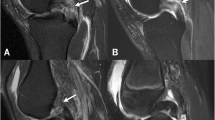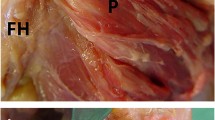Abstract
To evaluate the feasibility of identifying the anterior and posterior meniscofemoral ligaments (aMFL and pMFL, respectively) at arthroscopy, both visually and using the “meniscal tug test”, which exploits the anatomical attachments of the posterior cruciate ligament (PCL) and MFLs. This is an observational type of study. Arthroscopy using anteromedial and anterolateral portals was performed in 68 knees in 68 patients (36 right, 32 left). The MFLs were identified using several anatomical cues, including their femoral and meniscal attachments, their obliquity relative to the PCL, and the meniscal tug test. Identification was classed as easy or hard by the operating surgeon. From 68 knees, the aMFL was seen and confirmed to be an MFL using the tug test in 60 (88%). Identification of the aMFL was classed as easy in 64 (94%), whilst the pMFL was easy to identify in only 6 (9%) of knees, of which 3 had a ruptured PCL. Thus, with the exception of PCL-deficient knees, it was felt that the meniscal “tug test” as applied in this study was not suitable for the pMFL. The study shows that identification of the aMFL is possible in most knees at arthroscopy, using the “tug test” and other anatomical cues. However, identification of the pMFL may require a posterior portal. A subgroup of PCL injuries in which the MFLs were intact was also observed. The “meniscal tug test” can be used in arthroscopic examinations of the PCL to distinguish between fibres of the true PCL from the MFLs, thus avoiding the misdiagnosis of partial versus complete PCL rupture. This will also aid studies examining the role of the MFLs in stabilising the PCL-deficient knee.









Similar content being viewed by others
References
Ahn JH, Chung YS, Oh I (2003) Arthroscopic posterior cruciate ligament reconstruction using the posterior trans-septal portal. Arthroscopy 19(1):101–107
Amadi HO, Gupte CM, Bull AMJ, Lie DTT, McDermott ID, Amis AA (2004) Meniscofemoral ligaments reduce tibiofemoral contact pressure. Trans Eur Soc Knee Surg Sport Traum Arthrosc 11:13
Amis AA, Bull AM, Gupte CM, Hijazi I, Race A, Robinson JR (2003) Biomechanics of the PCL and related structures: posterolateral, posteromedial and meniscofemoral ligaments. Knee Surg Sports Traumatol Arthrosc 11:271–281
Cho JM, Suh JS, Na JB, Cho JH, Kim Y, Yoo WK, Lee HY, Chung IH (1999) Variations in meniscofemoral ligaments at anatomical study and MR imaging. Skelet Radiol 28:189–195
Clancy WG J, Shelbourne KD, Zoellner GB, Keene JS, Reider B, Rosenberg TD (1983) Treatment of knee joint instability secondary to rupture of the posterior cruciate ligament. Report of a new procedure. J Bone Joint Surg Am 65:310–322
Grover JS, Bassett LW, Gross ML, Seeger LL, Finerman GA (1990) Posterior cruciate ligament: MR imaging. Radiology 174(2):527–530
Gupte CM, Bull AMJ, Thomas RD, Amis AA (2003) A review of the function and biomechanics of the meniscofemoral ligaments. Arthroscopy 19(2):161–171
Gupte CM, Bull AMJ, Thomas RD, Amis AA (2003) The meniscofemoral ligaments: secondary restraints to posterior drawer. Analysis of anteroposterior and roatatory laxity in the intact and posterior cruciate ligament-deficient knee. J Bone Joint Surg Br 85(5):765–773
Gupte CM, Smith A, Jamieson N, Bull AMJ, Thomas RD, Amis AA (2002) Meniscofemoral ligaments—structural and material properties. J Biomech 35(12):1623–1629
Gupte CM, Smith A, McDermott ID, Thomas RD, Bull AMJ, Amis AA (2002) Meniscofemoral ligaments revisited: anatomical study, age correlation and clinical implications. J Bone Joint Surg Br 84(6):846–851
Kusayama T, Harner CD, Carlin GJ, Xerogeanes JW, Smith BA (1994) Anatomical and biomechanical characteristics of human meniscofemoral ligaments. Knee Surg Sports Traumatol Arthrosc 2:234–237
Lee BY, Jee WH, Kim JM, Kim BS, Choi KH (2000) Incidence and significance of demonstrating the meniscofemoral ligament on MRI. Br J Radiol 73:271–274
McCormack D, McGrath J (1992) Anterior menisco-femoral ligament. Clin Anat 5:485–487
Miller TT, Stein BE, Staron RB, Feldman F (1998) Relationship of the meniscofemoral ligaments of the knee to lateral meniscus tears: magnetic resonance imaging evaluation. Am J Orthop 27(11):729–732
Wan AC, Felle P (1995) The menisco-femoral ligaments. Clin Anat 8:323–326
Yamamoto M, Hirohata K (1991) Anatomical study on the menisco-femoral ligaments of the knee. Kobe J Med Sci 37:209–226
Acknowledgements
The Royal College of Surgeons of Edinburgh, the Smith and Nephew Foundation, The Aircast Foundation and the Wishbone Trust.
Author information
Authors and Affiliations
Corresponding author
Rights and permissions
About this article
Cite this article
Gupte, C.M., Bull, A.M.J., Atkinson, H.D. et al. Arthroscopic appearances of the meniscofemoral ligaments: introducing the “meniscal tug test”. Knee Surg Sports Traumatol Arthrosc 14, 1259–1265 (2006). https://doi.org/10.1007/s00167-006-0088-8
Received:
Accepted:
Published:
Issue Date:
DOI: https://doi.org/10.1007/s00167-006-0088-8




